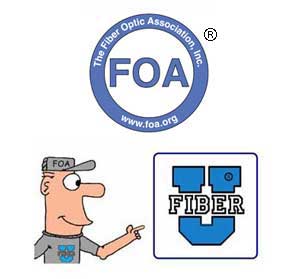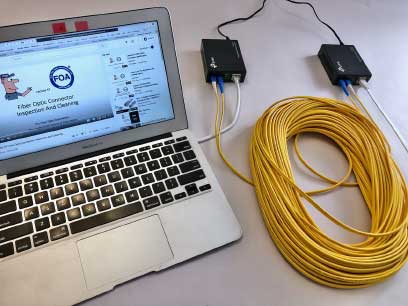Fiber
Optic Media Conversion MiniCourse
Fiber
U MiniCourses are courses on a specific topic that you can
take in about an hour or less. They are based on questions
people ask FOA all the time, so the topics are recommended
by our readers.
Level: Intermediate
Intended For:
Designers
of fiber optic communications networks
Users
of fiber optic communications networks
Contractors and techs who install, operate and maintain
them.
Objectives:
From this self-study program you should learn:
Communications
devices are electronic but backbone connections are by
fiber optics
How
fiber optic links work
How
transceivers and media converters interface electrical
and optical communications media
- Prerequisites

When
you finish, you can take an online test on this course to
qualify for a "Fiber U Certificate of Completion." The
test cost for a Fiber U MiniCourse is $10US.
Introduction
Electronic devices communicate internally
using electrons on conductors and communicate with other
devices using copper cables. radio waves (wireless) or
fiber optics. Most hardware like computers
comes with an Ethernet port for connecting to the Internet
or LANs that requires a Category 5/5e/6/6A unshielded
twisted pair (UTP) cable connection. Laptops, smaartphones
and tablets include a wireless (WiFi) connection also.
Video cameras usually have a coaxial cable connection. All
of these often require connections into fiber optic
networks since fiber optics is the backbone of the world's
communications.
Conversion to fiber is also desirable sometimes because of
fiber's immunity to electromagnetic interference or
ability to communicate over long distances.
This Fiber U MiniCourse will explain how fiber optic links
work, how transceivers in many types of equipment make the
conversion to fiber optics and how media converters can
convert electronic signals to fiber when needed.
Assignments
For
this lesson plan you will be instructed to watch the
videos, read
the references
and take a quiz (Test Your Knowledge) to complete the
course.
Lesson
Plans
Watch
the videos, read the section in the FOA Guide and take
the quiz. For this course, we recommend watching the
videos first and then reading the FOA Guide page on
Restoration. There is a short quiz you can use to check
your comprehension. The Certificate of Completion test
is based on those materials.
Videos
FOA
Lecture 58 Fiber Optic Media Conversion
FOA Guide
Converting
Other Media To Fiber Optics Using Media Converters
Do-It-Yourself Lab: Build
a working fiber optic link with media converters.
Test Your Comprehension
Fiber
Optic Media Conversion Quiz.

When
you finish all the assignments you can take an online test
on this course to qualify for a "Fiber U Certificate of
Completion." The test cost is $10US.
Go here to take the "Fiber
U - Media Conversion" Certificate of Completion test.
Here
are detail directions if this is your first time
taking a Fiber
U Certificate of Completion exam.
This information is
provided by The Fiber Optic Association, Inc. as a
benefit to those interested in teaching, designing,
manufacturing, selling, installing or using fiber optic
communications systems or networks. It is intended to be
used as an overview and/or basic guidelines and in no
way should be considered to be complete or
comprehensive. These guidelines are strictly the opinion
of the FOA and the reader is expected to use them as a
basis for learning, as a reference and for creating
their own documentation, project specifications, etc.
Those working with fiber optics in the classroom,
laboratory or field should follow all safety rules
carefully. The FOA assumes no liability for the use of
any of this material.
|



